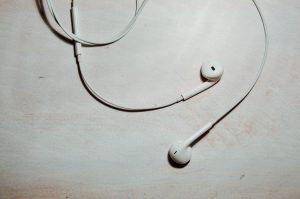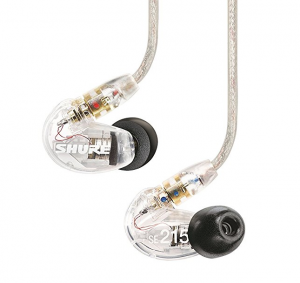
What Is An In-Ear Monitor? – Do IEMs Sound Better?
You’ve probably seen a musician on stage at a live show, or in a music video, wearing what look like earplugs attached to cords in their ears. What’s in their ears? Why would someone who’s playing live music wear headphones on stage?
They’re actually wearing an important piece of audio equipment called in-ear monitors (IEMs for short). What is an in-ear monitor? Keep reading to learn all about their purpose, exclusive features, and why you might be able to benefit from using them.
Earbuds vs. IEMs – Is There a Difference?
It seems that the general consensus for using standard earbuds vs. IEMs really boils down to personal preference. If you’re someone who uses your earbuds for when you’re out and about, and your over-ears for at home, you understand.

Since they’re also more compact than a pair of Bose QC35s, they’re much easier to carry in your pocket, backpack, or purse. It’s not always practical to bring your bulkier pair of headphones along for the day (even if they’re your favorite).
Different Styles for Different Purposes
There’s a reason why so many different headphone options are available to pick and choose from. Each different style can serve a different purpose than the other. IEMs are primarily used by musicians on stage or in studio, or audiophiles/music fans that pay extra special attention to the sounds they listen to.
I’m sure you’ve had that moment where you try putting your earbuds into your ears for the first time, and realize that they don’t fit as well as you’d like them to. More likely than not, anyone who’s ever purchased a pair of earbuds has had that same exact experience.
It’s pretty common to hear complaints about the earbud not staying in place, falling out, or giving you issues while you’re running or working out. The design of IEMs was made with that concern, and others in mind.
Fit – Ear Canal
In-ear monitors fit into your ear differently than any other type of listening device out there. As we went over above, the silicone (most-commonly used material) ear sleeves do come in different sizes and shapes. Even though you’ll have a few options to choose from, they still might not fit just right.

This is definitely one area where IEMs really outshine the others. You can find a quality pair of these on Amazon, but for a truly perfect fit, there are companies that specialize in the detailed design.
Custom-Molded IEMs
There are companies that make custom-molded IEMs designed to fit your specific ears. One reason why custom in-ear monitors cost so much more is because the fit and noise-isolating features can’t be replicated by using the standard silicone ear sleeves.
The process requires specialized professionals ranging from audiologists, to those trained on how to take ear measurements, mold, and design your custom ‘buds.
Depending on the company that designs your IEMs, you can also personalize the artwork on the outside of the faceplate as well as the carrying case.
It’s an extremely detailed process that you can watch in the approx. 15 minute video below:
Noise-Isolation Features
The noise-isolation features will be much better on a pair of custom-made IEMs but even the non-custom options utilize this feature. Since the actual earbud will sit inside your ear canal, you won’t need to worry about whether or not the ones you got have noise-cancelling capabilities.
Noise-isolation is a feature that blocks out ambient noise in the same way that a pair of earplugs do. As opposed to noise-cancelling, noise isolation utilizes different styles of design and fit to block out unwanted sound.
Depending on your occupation, you might wear earplugs to protect your ears from the extremely high decibel levels produced by machinery.
You also might be someone who throws a pair of earplugs in at night to help you sleep better, free from external noise. Either way, the IEMs use the same idea except you can also listen to music/media at the same time.
Comfort – During Longer Listening Sessions
By now, you’re probably wondering if this style will stay comfortable (especially since they’re actually securely inside your ear).
It might take some time to get used to putting these into your ears if you’ve never used them before. Most pairs work well for those of you that like to wear hats or glasses. Some people have used models such as Shure’s SE215s to sleep in, while others say that they do get a little uncomfortable after a few hours of listening.

Although you can find some pretty comfy non-custom IEMs, many users will tell you that you can’t compete with the custom-molded fit. They may not necessarily be the most comfortable (due to the material they’re made of), but the actual fit is hard to beat.
Just like our fingerprints, each of our ears are individually unique. As much as companies would like to be able to accurately predict the individual size and shape of our ears, it’s not exactly realistic to get the perfect fit. Luckily for us, there are some out there that get pretty close.
Situations Where You Might Benefit From Using IEMs
As mentioned above, there are certain situations where you will benefit from using IEMs rather than your other favorite pair of headphones.
Walking Outside
Some people choose to use theirs when they go outside for a walk or to the store. The reason could be as simple as a purely aesthetic choice. Some headphones (especially over-ear models) can be pretty bulky and stick out on the sides. If you don’t like to draw attention to yourself, it makes sense to use a smaller pair to listen with in public.

Some Things to Consider For Outside Use
On the other hand, if you like to be able to hear some of your surroundings while you’re walking around, it might be better to listen with something else. It can be pretty hard to hear oncoming traffic, passing bikers, and other pedestrians due to the noise-isolation they provide.
At-Home Listening – Your, Yourself, and You
Another reason you might want to use IEMs is if you’re at home and you don’t need to be as aware of your surroundings. Much like soundproofing a home studio or music room, this effect can be replicated on a smaller scale. Let’s say you do want to block everything out of your ears, except for the music.
IEMs would be perfect for that. You can throw them in your ears, plug in your amp, turn the music all the way up, and enjoy your favorite album without any distractions.
Sound Quality – Do They Sound Better?
One of the most commonly-asked questions about this style of headphone, is “Are they really worth it, do they actually sound that much better?”. If you pair the noise-isolation features with the in-ear canal fit, it seems reasonable to expect that they would.
It’s not uncommon to hear feedback about even less-expensive IEMs sounding better than over-ears. Although sound quality will vary by specific model and company, they usually give you a well-rounded soundscape.
Different Types of Drivers
This will also depend on the type of drivers installed in your monitors. Balanced armature drivers produce clear sound (with less bass response). They respond to a frequency response that’s more focused on the highs and mids.
Another commonly used driver type are dynamic drivers. This type of driver will respond to a wider range of frequencies. Usually, this means that the lows will be more powerful, while not sacrificing the highs and mids.
Here’s a short video explaining the difference between balanced armature and dynamic drivers:
Does The Number of Drivers Matter?
A driver is basically a mini speaker. Some IEMs contain more than one driver per ear (up to 4 in some cases). Depending on who you ask, some people will tell you that having more than one driver in each ear cup/bud makes the sound fuller and more pristine.
Others (audio is subjective in a lot of ways) will tell you that a pair of IEMs/headphones can perform just as well with only one driver per ear.
For Music Fans
Some music fans and audiophiles prefer listening to music with IEMs over other commonly used models such as over-ear, earbuds for working out, or on-ear headphones.
IEMs can be a great addition to your audio gear collection if you’re willing to spend the money for what many claim to be the best headphones available for listening to music.
For Musicians

IEMs serve an important purpose for musicians. Many musicians use them on stage to block out extra background noise and monitor a backing track, click track, or the sound of their own instrument.
Playing shows night after night after night can start to take a toll on your hearing. It’s important to keep your ears healthy so you can keep playing later in life.
The sound isolation feature of IEMs (especially custom-molded) helps preserve your hearing, even though your equipment on stage is turned all the way up.
Watch this video to see a professional musician describe how, and why you can benefit from using IEMs:
Average Cost
You can find a quality pair of in-ear monitors for around a couple hundred dollars from brands like Shure, Fender, or Sennheiser. Although they’re not tailored and crafted to your specific ear canal, they will definitely elevate your listening.
The real gold would be you investing in a pair of the custom-molded IEMs if you can afford it. Much like almost every custom-made item that you can think of, IEMs tend to be pricier than other earbuds, as well as some over-ear headphones.
When it comes to making a purchasing decision, it’d be wise to consider what you can and can’t live without (while referencing the features above). I wouldn’t want to convince you either way, because ultimately it’s totally up to you.
We all use our earbuds and headphones in our own ways. The most important thing is that you find a pair that works for you and caters to your needs. In my opinion, a custom pair of IEMs would be worth the extra cash for professional musicians, super-dedicated music fans, and audiophiles.
Wrapping Up – Everything You’ve Learned So Far
Whether or not you’re ready to make the jump into the world of custom-molded IEMs, or the universal pre-made versions (like the Shure SE215s), now you know what to expect. You learned what an IEM does, how it’s different from the more standard earbuds, and some of the different uses/situations where you can benefit from using them.
Your question of “What is an in-ear monitor?” should have been answered and you got to watch a few great videos explaining the entire process from start to finish. Next time you go to a live concert, you can be the one to tell your friends all about IEMs, and the reasons why they’re uniquely distinct from other types of headphones.
Thanks for stopping by to learn about this type of headphone! If you do happen to have any more questions, feel free to ask or leave a comment below. I will be sure to respond as quickly as I can!

Sonic Elevation: Ride The Waves.
- Korg B2 vs Roland FP10 | Which One To Buy - May 13, 2021
- How Does Music Affect The Brain? – Let’s Find Out! - April 6, 2021
- Why Are My Headphones Crackling? – How To Fix It - April 3, 2021

Dom, that was an impressive article. I have never really given much thought to ear buds and listening devices, but I have learned so much in the past fifteen minutes, I am a changed man. Why wouldn’t someone want the highest quality listening devices they could get? Thank you for the in depth information.
Clay
I appreciate it Clay, I’m glad you were able to learn more about In-Ear Monitors. There are a lot of different areas to explore in the world of audio (even though it might seem like headphones are just headphones).
Who knows, maybe you’ll end up grabbing a pair to try out for yourself in the future. 🙂
Thanks again for stopping by!
I’m always looking for good ear devices. I have small ears so the standard earbuds that come with devices such as MP3 players and mobile phones really dig in and start to hurt my ears after around twenty minutes of listening to something.
I have my over ear device for use at home but they are far too big tobe walling about town with, not to mention they look way silly.
These IEM’s look like they may be a perfect solution.
I had no idea that these could be used like earbuds. I have seen artists with them but I thought they were for producers or whatever to speak to them when they were perfoming live.
Do they come in a standard size or can you get different sizes? i know you mentioned custom fitting but I would wager that is expensive?
Thanks for the information.
You’re definitely not alone on feeling that way Michael. A lot of people complain about their earbuds not fitting how they’d like them too.
In-ear monitors (especially custom-molded pairs) are the best way to go if you don’t mind paying more for a single pair.
I think that’s one of the most common misconceptions about IEMs. Although musicians do wear them on stage and sometimes while recording in the studio – they’re not the only people who can enjoy the high quality music they produce.
IEMs might be one of the “best-kept” secrets in the world of audio. (That is, of course, until you know that you can use them as a casual listener.)
If you haven’t had very good luck with the earbuds that you’ve tried so far I would suggest trying an entry-level pair of IEMs. You could grab a less-expensive pair like the Fender FXA6 or MEE audio M7 Pro. Both of them cost way less than getting a custom-molded pair.
They do tend to cost a bit more than your average pair of earbuds but you’ll be more than happy with the results. 🙂
I appreciate your questions – I’m glad I could help! Thanks for stopping by, I hope to see you here again!